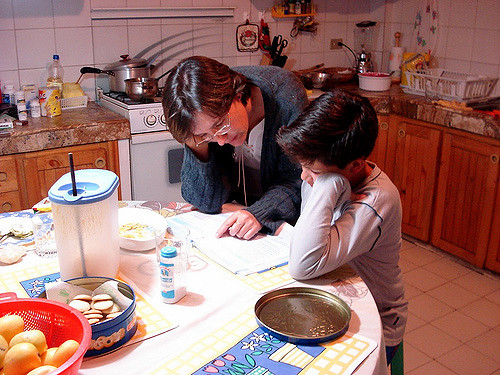There’s a large a growing body of research that shows the importance of peer effects on lifetime economic success of kids. For example, while the education level your parents is a strong determinant of your level of education, it turns out that the education level of your neighbors is nearly half as strong. Much of this effect has to do with the level of resources and performance level of local schools: people who live in neighborhoods with lots of well-educated people have schools with more resources and stronger parental support. And there’s also a fair argument that a better educated peer group provides access to social networks and role models that shape aspirations and opportunities.

A new University of Chicago working paper from Josh Kinsler and Ronni Pavan underscores another, more subtle way that peer effects operate in schools. It’s titled: “Parental Beliefs and Investment in Children: The Distortionary Impact of Schools.” We know that one critical factor in explaining student achievement is what education scholars call “parental investment.” By this they mean the amount of time (rather than money) that parents dedicate to helping advance their child’s learning by, for example, helping with homework, or participating in school activities, or arranging tutoring or extra-curricular learning opportunities.
The study uses data from a national longitudinal survey covering Kindergarten, First- and Third-Grade students, and looks at the connection between parental beliefs about student performance generally, and in math and reading, and how this the amount of time parents spend helping children do homework and similar activities.
Kinsler and Pavan find that there’s a strong correlation between parental beliefs about their child’s relative performance and their investment in these kinds of time intensive learning activities. Parents who think their children are at or above the average, tend to invest less time in doing things like helping with homework. And there’s the critical part of their finding: parents tend to base their assessment of their child’s performance relative to other students in his or her class or school, rather than other schools, or the state or nation as a whole. This is mostly unsurprising: parents are going to get most of their information about academic performance by comparing their child to his or her classmates.
But the effect of this “local bias” in comparisons is that parents of students attending low performing schools will tend to have an inflated assessment of how well their child is doing–relative to all other students. This over-optimism will lead them to under invest in helping with homework, and doing other things to enrich their child’s educational opportunities. Its well-understood that low-income and single-parent households already start off with more limited time and resources to help support their children’s education. What this suggests is that given all the competing demands for their time and attention, they may be lulled into a false sense that their children are doing “well-enough” in school. As Kinsler and Pavan conclude:
Parents of low skill children who attend schools where average skill is also low will perform fewer remedial type investments than parents of similarly able children who attend schools where average skill is higher. Because of the tendency for students and families to sort into schools and neighborhoods, low skill children are more likely to attend schools where average skill is also low. As a result, the distortion in parental beliefs generated by local skill comparisons leads to underinvestment for low skill children.
As a result, one of the subtle and pernicious ways that economic segregation and the concentration poverty influence children’s lifetime incomes is by giving parents (and probably children) too limited a basis for measuring their performance and lead them to under-invest in educational skills.
